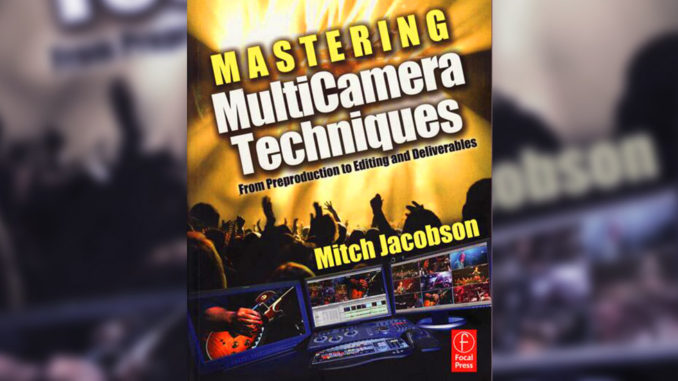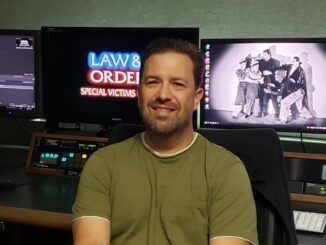
by Ray Zone
Mastering MultiCamera Techniques
From Preproduction to Editing and Deliverables
by Mitch Jacobson
Focal Press
Paperbound, 449 pps., $54.95
ISBN: 978-0-240-81176-5
This is a monster of a book, certainly the last word on this large and very complex subject that is of supreme interest, above all, to editors. In his Foreword to the book, Academy Award-winning multi-camera systems inventor Tom Ohanian recalls, “I can remember, early in my career, being faced with so many multi-camera-covered events where no one thought about the hapless editor who had to put the footage together. Where were the sync points? How could I establish sync? Why did they have to turn off the camera? Didn’t they realize the life of agony their actions were going to put both the editor and the director through later on?”
In his Introduction, author and Editors Guild member Mitch Jacobson observes, “Multi-camera production is surging” for every kind of program, from network studio shows to wedding videos. In writing the book, he states that his goal was to “demystify the multi-cam universe, allowing anyone with a couple of cameras (or more) to learn the same methods, and perhaps even achieve the same results, as the masters of multi-cam.” Accordingly, Jacobson has included interviews with and quotes from over 100 seasoned professionals in the world of multi-cam production. The concept for the book originated in 2000 when the author attempted to hire an assistant with multi-cam experience and found that finding someone with experience was a challenge. So he instituted a course of training that resulted in this book.
Jacobson notes that, primarily, “the book was written by an editor, for editors.” The book, about so much more than editing, however, is divided into six sections that trace the entire trajectory of a multi-camera production. They include Pre-Production, Production, Timecode and Sync, Post-Production Systems, Editing and, finally, Deliverables. A companion DVD includes multi-camera footage from two concerts, Paul McCartney: The Space Within US and another by Elton John. Readers can load up and edit their own concert clips from the DVD with more than 20 different angles. Free applications like AJA DataCalc, Sequence Liner and QT_CHANGE are also included on the DVD. The entire book is printed in four-color process with numerous photos, illustrations and handy icons that are used in very informative sidebars throughout.
“Editing is probably the most important part of production because it’s where sins are forgiven and greatness is established out of mediocrity.” – Mitch Jacobson
Pre-production is “the foundation of a multi-cam shoot” says Jacobson. Director Hamish Hamilton notes, “The edit process starts in pre-production. We’ll talk an editor through what I’m planning to do, what angles I’ve got and how many nights I’m shooting.” This is critical, especially for multi-cam shows. “A poorly planned shoot can wreak havoc on the editing phase, especially when multiple cameras are involved,” cautions Jacobson. The editor’s role in pre-production will be to prepare for the type of show, equipment testing, pre-labeling and numbering media, and the formation of a time code plan. This section of the book is nicely illustrated with a typical schedule for a shoot day and a director’s script from The Daily Show with Jon Stewart. Some very nice color graphics also illustrate the numerous HD, DV and digital formats and aspect ratios. With an example of a real nightmare-preventative tip titled “Noteworthy,” Jacobson writes, “In the tapeless workflow, it is not a good idea to rename the file, because if your NLE crashes and you have to go back to the camera files, you’ll have no cross reference to the name the camera has assigned the file.”
A chapter on Tape Labeling and Scene Numbering Systems begins with the succinct but truthful quote from an unknown author: “An unlabeled tape is a lost tape.” A variety of naming conventions and systems are covered. Mixed in with the technical survey are historical asides such as a profile of director Akira Kurosawa, who shot his feature films with a multiple-camera technique, very often using up to six cameras for a single shot. A well-illustrated chapter on Time Code Basics gives up-to-date information on the subject, which is important because, as an epigraph to the chapter by Roy Volkema, editor of HDNet Concerts, states, “We live and die by time code.” An excellent chapter on Computers, Bandwidth and Speed nicely demonstrates the bottom line, which is: “There’s no way around it really; working in multi-cam requires maximum bandwith and a CPU powerful to handle real-time decompression of your material.”
Jacobson gives detailed discussion to Avid and Final Cut Pro, along with Adobe Premiere Pro. He notes, “Most people who use Premiere Pro use it for the Adobe-centric workflow and integration benefits. Think of Premiere Pro as a conduit that you can use to get from editing to the Adobe suite products.” Premiere Pro, after all, only works with four camera angles at a time. The author has a lot of good things to say about Sony Vegas: “You can drop almost anything you want on a Vegas timeline and it will happily play. You can combine 24p footage with 29.97, PAL and NTSC. Mixed frame rates? No problem. Even frame rate conversions. You can mix it up however you want and tell it to display whatever time code you want. To Vegas, these are just calculations.”
A chapter on Cutting Techniques and Styles really sums up the importance of editing to the multi-camera technique with a quote by Mark Haefeli, producer/director of Paul McCartney: The Space Within US: “Editing is probably the most important part of production because it’s where sins are forgiven and greatness is established out of mediocrity.”




